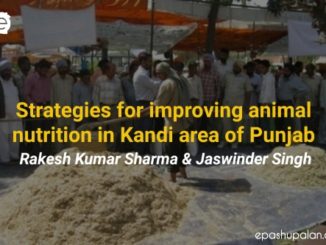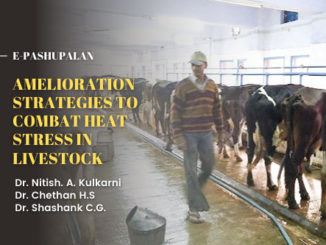Sheep are the excellent converter of grass into meat and wool. They do not require high cost building to house them and require less labor as compared to other kinds of livestock. Sheep possess a special capability to thrive on natural grasses and do not require to be given any supplemental feed except during certain physiological stages of life. In fact there is no substitute for sheep as a class of livestock for utilizing waste lands or weed from the field. No domestic or wild animal are capable of existing on more different sorts of food. Weeds, grasses, shrubs, roots, cereals, leaves, barks and even at times of scarcity, fish and meats all furnish a subsistence to this wonderful animal. This article aims at different aspects of feeding of sheep at different physiological stages of life.

Flushing
Improving the nutritional status of ewes during 3-4 weeks prior to mating is known as ‘flushing’. Nutrition and body condition of the ewes prior to putting them to ram are important. Flushing will have effect only if the ewes were in declining phase of nutritional availability. Ewes in better body condition will produce more lambs and thus the flushing of leaner ewes will increase the fertility by way of increased incidence of oestrus and increased ovulation rate.
- Provide the breeding ewe with flushing ration about 2 to 3 weeks before the beginning of the breeding season, to promote their growth and obtain optimum body weight.
- This practice will bring ewes into heat earlier in the season thereby giving early lambs and resulting in a more uniform lamb crop.
- Flushing also increases the lambing rate and incidence of multiple births in the flock.
- To obtain increased lambing rate, the breeding ewes should be supplemented with 250g of concentrate mixture or 500 g of good quality legume hay per head per day.
Suggested flushing rations
- A good mixed pasture of legumes and grasses.
- A grass pasture along with 150 g of wheat bran per head per day.
- Grass pasture plus 250 g of grains and 450 g of oil cakes.
- Legume hay full fed along with 100 g of wheat bran and 150 to 200 g of grain.
- Green fodder at the rate of 10% of body weight and 150-200 g of concentrate per head per day.
Pregnant Ewes
The foetus makes two-thirds of its total growth during the last 6 weeks of pregnancy. The consequences of under-nutrition in late pregnancy are reduction in lamb’s birth weight, poor milk production and poor lamb survival. Under-nutrition may also result in occurrence of pregnancy toxemia which results in collapse and possible death of the ewes. There is production of ketone and acetone bodies in the blood from the rapid breakdown of body fat to meet the energy requirements of advanced pregnancy. Thus, the amount of nutrients, especially energy, must be increased during the later part of pregnancy to ensure proper growth of foetus and high milk production.
Feeding ewes during early and mid-pregnancy
- Good feeding during gestation is essential for a healthy strong lamb crop.
- If feeding is inadequate or defective, weak or dead lambs will result.
- It increases the number of strong healthy live lambs born.
- It prolongs the productive life of the ewes.
- It increases milk yield by the ewes resulting in healthier weanlings.
- It also improves the wool productivity.
- It lessens the incidence of lambing paralysis.
- It decreases the probability of ewes disowning their lambs as a result of exhaustion and weakness.
Suggested rations for ewes during this period
- Grazing: On a good pasture. .
- Sorghum silage: One to two kg. Sorghum silage plus legume hay half to one kilogram per head per day.
- Ad libitum supply of maize or sorghum fodder plus 50g of oil cakes like groundnut cake, per head per day.
- Grazing on stubbles and harvested fields supplemented with 100 g of oil cakes per head per day.
Feeding ewes during late pregnancy
- During this period ewes may be allowed to graze on crop aftermaths (crop stubbles), wild grasses and weeds.
- Their ration must be supplemented with available green fodder fed at the rate of 5 kg per head per day.
- During the last one month of pregnancy the foetus grows rapidly in the uterus.
- Lack of enough energy in the feed can lead to pregnancy toxemia in ewes.
- Molasses or grains (barley, maize, oats, etc.) may be fed at the rate of 225 g per head per day.
- Further, ewes should also receive available green fodder at the rate of 7 kg per head per day or
- 600 g of quality legume hay or 300 g of concentrate with 12 to 14 % DCP and 65 to 70% TDN during last 45 days of pregnancy.
Lactating Ewes
The requirements of energy and protein are higher during lactation. During early lactation sufficient quantity of good quality grazing and supplementary concentrate or legume hay or dry tree leaves should be provided as the demand for energy in lactation is very high. The lactation ewes require concentrate supplementation on even higher rate than the advanced pregnancy. Lactation also causes to mobilize body reserves of fat which is replaced with water. They should also be fed a high level of energy in early lactation.
A high protein diet improves the yield of milk but at the cost of the body reserves and hence both energy and protein should be balanced in the diet of lactation sheep.
- Ration for lactating ewes must be supplemented to maintain adequate milk production, which is necessary for rapid growth of lambs.
- If they are provided good pasture, the requirements are more or less met. When supplementary feeding is necessary, the amount of additional feed may be calculated as follows:
- An average ewe’s daily pasture requirements can be replaced by 50 per cent by 450 g of good hay, 1.4 kg silage or 250 g of grain.
- If they are fed cultivated green fodder, 10 kg per head is sufficient or 400 g of concentrate mixture or 800 g of quality legume hay per day for 75 days after lambing in addition to 8 hours of grazing.
Colostrum feeding of lambs
A lamb should get sufficient amount of colostrum (first milk) from the mother during the first few days after birth. It imparts passive immunity, through gamma-globulins in which colostrum is very rich, against a number of infectious diseases against which the mother has been vaccinated or to which it has more recently been exposed to. There is no other way of protecting young lambs against these infectious diseases as they do not have their own immune system yet developed. Colostrum is also a rich source of energy and nourishes the newborn lamb, and acts as a laxative to clear the gut of the meconium. Colostrum is richer than milk in protein, vitamins A and D, cobalt, iron and lactose. If some lambs are orphaned and no ewes are available for fostering, it is necessary to rear them artificially.
- The lamb should be allowed to suck its dam for the first three or four days so that they can get good amount of colostrum.
- Colostrum feeding is a main factor in limiting kid losses.
- Cow colostrum is also efficient for lambs.
- Colostrum is given at the rate of 100 ml per kg live weight.
- Colostrum can be preserved with 1-1.5% (volume/weight) propionic acid or 0.1% formaldehyde. Propionic acid is preferred for preservation as it keeps the pH value low.
- The chemically treated colostrum is kept at cool place to ensure better quality.






2 Trackbacks / Pingbacks